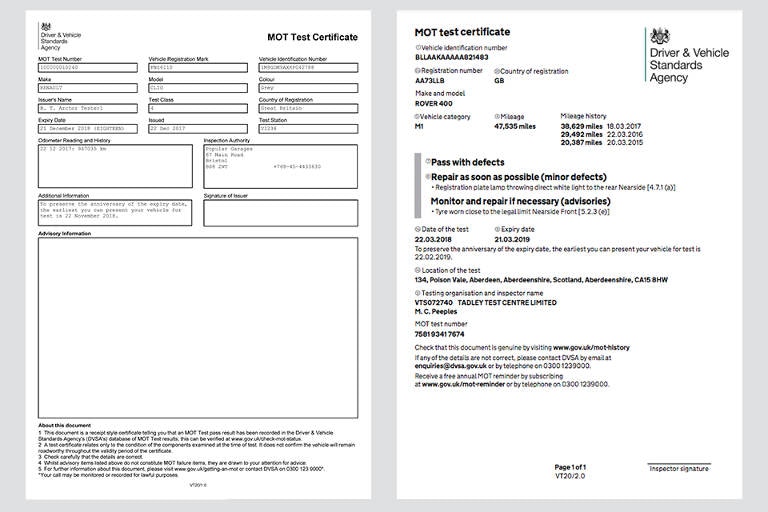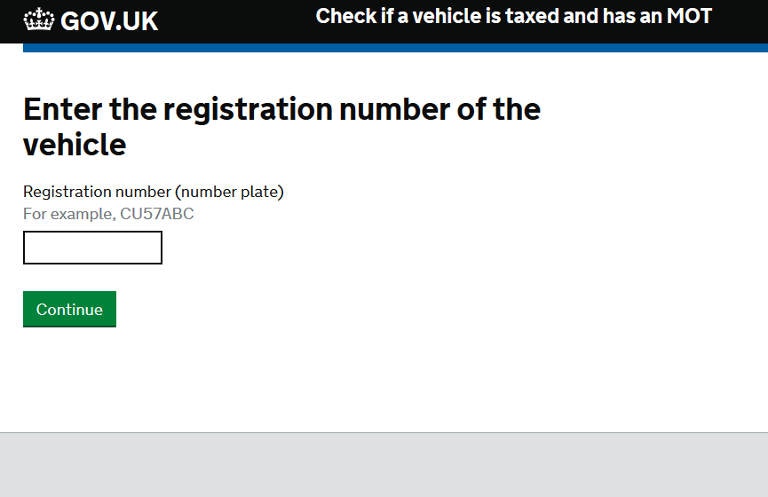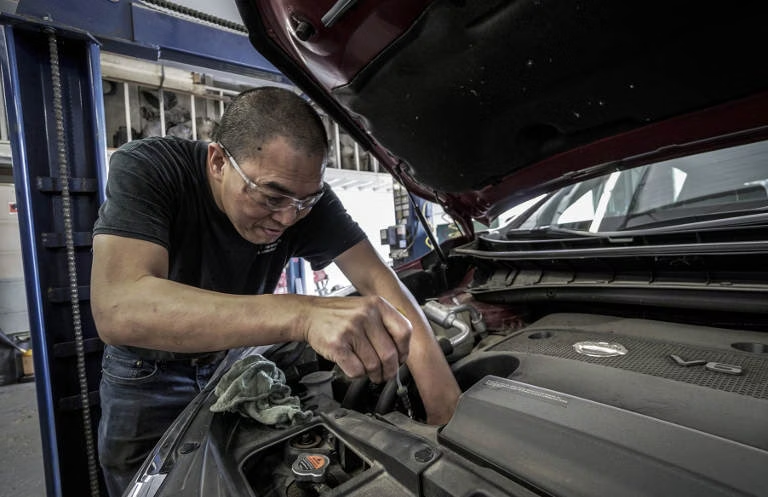MOT – the ultimate guide

In the UK by law, every car over three years old requires an annual MOT check and an MOT certificate to legally be able to drive on UK roads. But what’s it all about?
The MOT test process is actually quite a mysterious one to many car owners. Every year you’re required to leave your vehicle at a garage or test centre, then sit, wait and hope it doesn’t mean a big bill for repairs. It is, therefore, rarely something to look forward to.
But understanding MOTs is important when it comes to buying, selling, transferring ownership as well as driving your car safely.
Not having a valid certificate could mean risking a fine, points added to your licence, and a driving ban. And it also has a big impact on the price when you’re buying or selling a vehicle.
So, our guide to the MOT will explain why it exists, what testers will check, and how to deal with problems like losing your certificate.
We’ll also provide you with tips to help save money by checking for simple MOT failures yourself and help you with finding the right test centre. We call it the ultimate guide to MOT for good reason…
So why is the MOT test so important? The MOT explained:
- MOT explained / MOT rules 2021
- Which cars are exempt from the MOT test?
- How do you check your MOT history
- How to check any car’s MOT history
- How do you check when your MOT is due?
- How your MOT affects car tax and insurance
- How much does an MOT cost?
- How to find a local MOT centre or garage?
- How to sell a car without an MOT
- What fails an MOT in 2021? Common reasons for failing
- Top tips to pass your MOT

What is the MOT?
The abbreviation MOT actually stands for the Ministry of Transport, which was the Government department responsible for the roads when the MOT was first introduced in 1960.
When it was first introduced, an MOT test was only required after a car was ten years old. That’s been reduced a lot since 1960, and the list of checks has also been expanded as time has passed.
The purpose of an MOT is to check the safety, roadworthiness, and exhaust emissions of the vehicles on UK roads. It covers vehicles from small motorcycles under 200cc to the biggest lorries. It was designed to help prevent you from driving a car that has a potentially dangerous fault.
In May 2018, the Government introduced tougher new measures for MOT tests, leaving more than one million cars labelled ‘dangerous’ by the end of the year. The tests are not getting any easier.
The MOT test includes a range of checks on various parts of your car to make sure they meet the minimum standards laid out by the Driving and Vehicle Standards Authority.
These include checking the Vehicle Identification Number (VIN) is present and legible and a check that your registration plate (number plate) is secure, legible, and in the correct format.
The MOT test also includes checks on:
- Lights
- Steering and suspension
- Wipers and Washer Bottle
- Windscreen
- Horn (beep beep!)
- Seatbelts
- Seats
- Fuel System
- Emissions
- Bodywork
- Doors
- Mirrors
- Wheels and tyres
- Brakes
Many of these items are quick and easy to check yourself before taking your car for its MOT test. This means you can avoid having to pay for a retest or repairs simply because you had a faulty light bulb or an empty windscreen washer bottle.
How do you prove you have an MOT?
When your car has completed a successful MOT test, you’ll receive a VT20 MOT Test Pass certificate. The design of the MOT certificate changed in May 2018 to a new A4 design that lists any faults and defects in a way that’s hopefully clearer and easier to understand.

If the MOT computer system isn’t working for any reason, an MOT tester can fill in a ‘Contingency MOT test certificate’.
If your car fails the MOT test, you’ll be given a VT30 MOT Test Failure certificate.
You can see samples of all existing and previous MOT pass certificates here. And samples of failed MOT test certificates here.
Replacing a lost or damaged MOT test certificate
It’s important that you have a current, valid MOT certificate. So if you lose or damage your paperwork, it’s wise to get it replaced as soon as possible.
You can get a replacement MOT Test Certificate from any MOT test centre. So you don’t need to go back to the place that originally performed the MOT.
Supply them with the vehicle registration details, and the V5C log book reference number, and they will give you a replacement document. It can cost £10 or half the full MOT test fee, whichever is the smaller amount.
Although you can check the current MOT status and history of cars online, unfortunately, you can’t order a replacement MOT certificate.

Which cars are exempt from the MOT test?
Some cars are not required to take MOT tests. This means you can avoid the annual check if your vehicle is either very new, or very old.
- Cars less than 3 years old from the date of manufacture or registration. These are usually new cars under warranty, so don’t need testing
- Classic cars manufactured or registered 40 years ago or more that have not been ‘substantially changed’.
If you own a historic vehicle and you’re not sure whether you need an MOT, it’s worth reading the Department for Transport guidance. They also link to the Federation of British Historic Vehicle Clubs for more specific expert advice on your make and model of car.
You’ll have to fill out an MOT exemption form (Form V112). You’ll also need to fill in the form to either purchase your car tax or apply for an exemption.
How do you check your MOT online?
Lots of websites will now let you check your MOT status for free online (including the DVLA itself). You can use them if you’ve lost or temporarily misplaced your certificate/need to check when your MOT is due. Or if you’re researching a potential car purchase and want to know if the car has passed.
Trusted third-party websites offering MOT status checks include Confused, Halfords, Regit, and the AA, but there are many more that offer one. The best ones also include the manufacturer service schedule if available.
All of the online services will also allow you to sign up for reminders so you don’t miss your MOT date by mistake. All you need is your registration number or the number plate of any car you’re thinking about buying.
But let’s concentrate on the official MOT checker…
The Government MOT checker from the DVSA
The Gov MOT checker service includes both your MOT and Vehicle Tax details as stored by the DVLA/ DVSA.
All you need to do is enter the Reg details and confirm the type of car it finds. You’ll then see a detailed description of the vehicle, along with the MOT and tax due dates.

It also includes the year of manufacture and registration.
How do you check your MOT history?
As with the current MOT status, it’s easy to find a variety of services all offering the MOT history of a vehicle. For example, both HPI and the AA offer historical records. Although for the AA you’ll need to sign up to their email service to get access.
As an alternative, you can check both MOT history and future dates with CarGuide for free, or you can go straight to the source of information, by accessing the DVSA details directly.
Gov MOT history checker
By going to the Gov.uk MOT history checker, you can view results for tests performed in England, Scotland, or Wales since 2005. You only need the registration number of the vehicle. The results are added when the MOT test centre upload results at the end of a test.
You can then see all historic test results, including MOT passes and fails. So you can see what minor defects might still be present on the car. And what has caused it to fail an MOT test in the past.

You can also access the location of each MOT test if you have access to the V5C number from the logbook.
How do you check when your MOT is due?
With a fine of up to £2,500 for driving on UK roads without a valid MOT, three penalty points, and a driving ban, it’s well worth making sure you don’t miss the date by mistake.
That’s before the implications for your insurance cover (which can vary) or other complications as a result.
You can check the due date by looking at your VT20 MOT Pass certificate. Or by using the various online services to remind yourself of the date, including the Gov MOT checker. But don’t just leave it there…
Every site, including Gov.uk, will offer a reminder service. For example, the Gov.uk reminder service will text or email you one month before your MOT is due. And again 2 weeks before the date if you still haven’t got your car tested.
If you’d prefer not to share your email address or mobile number, then just use make sure to include the MOT date in whatever type of calendar you use.
How your MOT affects car tax and insurance

A valid MOT pass certificate isn’t just required to legally drive your car on the public highways. It’s also a requirement for other services, including your car tax and insurance. This means forgetting your MOT can have a knock on effect on everything else.
Do you need an MOT to tax your car?
A valid MOT is a requirement for taxing your car online or at the post office. If you’re not driving or taxing your car as it’s off the road, you should declare a Statutory Off Road Notification (SORN).
The biggest complication comes when both your road tax and MOT are due at the same time and the tax runs out before an MOT pass.
So it’s worth either taxing your car slightly earlier or going in for an MOT up to 30 days before the due date to avoid them clashing. Otherwise, you may be able to legally drive without an MOT to the nearest test centre, but you’ll potentially be at risk for not having valid road tax.
Do you need an MOT to insure your car?
If you’re driving and insuring your car to use on the road, then you’ll need to have a valid MOT to be legal. But it’s not necessarily a requirement to get car insurance or to receive a payment in the event of a theft or accident.
You may need to take out insurance on a car that has been declared SORN and is kept away from the public highway. Or you may need cover in order to travel to the MOT test itself.
If you’re driving without a valid MOT for any other reason, your insurer may declare your policy invalid. However, this depends on the insurance company and their policy documents.
This has occasionally been challenged by the Financial Ombudsman when an insurance company has refused payments on the grounds of not having an MOT if the condition of the vehicle has had no bearing on an accident.
However, if you do make an insurance claim on a car without a valid MOT you can expect the payout to be lowered to the value of a non-MOT’d car which is significantly lower.
How much does an MOT cost?
There’s no minimum cost for an MOT test, but the maximum fee for a car is set by the DVSA at £54.85. It also shouldn’t take less than 45 minutes as that is the time the DVSA has set as a minimum for a test.
However, you might find cheaper deals by shopping around as garages will hope to attract more repeat business by getting you to bring your car in for a cheap MOT.
If your car is likely to be fault free, then it’s worth looking for the cheapest offer. But if you suspect significant repairs might be needed, then it might be better overall to go with a garage you’ll trust to complete the work.

The new MOT rules from May 2018 mean that if you fail on a dangerous fault, you might not be able to drive away until it’s fixed. That can mean paying more for repairs if you choose a garage just on the basis of a cheap MOT offer.
This also applies to council MOT test centres, which have long been a way to save money.
These facilities are usually for council vehicles, but must be open to the general public and usually don’t do repairs. So there’s no incentive for them to find faults for the sake of it, and this means the cost can often be cheaper.
In the event of an MOT test fail, fees can vary. If it’s left at the test centre for repair and it’s retested within 10 working days, there’s no fee.
If you take the car away for repairs and then get back to the test centre before the end of the next working day for a partial retest, then there will also be no cost. However, if you return after 10 working days, then you’ll be charged a partial retest fee.
How to find a local MOT centre or garage
It’s easy enough to find your local MOT centre or garage with a quick Google search. And alongside smaller local garages, you’ll also find the latest offers from national brands like Kwik Fit and Halfords. You can also use Google to find Council MOT centres.
It’s also worth asking friends and family, or via social media, for recommendations of good local garages for your MOT.
How do you sell a car without an MOT?
Can you sell a car without an MOT if you don’t want to go through the testing process for any reason?
Sometimes it just doesn’t seem worth the time and effort, particularly for older cars with little value and lots of potential problems. But is it legal? And does it have any disadvantages? Let’s answer that question…
Can you sell a car without an MOT?
The simple answer is that yes, you can sell a car without a valid MOT certificate. But there are some downsides.
Obviously, it can’t be legally driven and tested by any potential car buyer on the road. And it will need to be taken away on a trailer or lorry, which can delay the sale and removal.
Selling a car without an MOT will mean a smaller group of potential buyers, and it also means the sale price may be significantly lower than if you had a valid test certificate.
But it’s certainly an option if you just need the space in your garage or on your driveway. Beware of owners trying to sell on cars without an MOT though – they are much more likely to be of Cat D status and could be dangerous!
Who will buy cars without an MOT?
The biggest buyers of cars without an MOT tend to be online car buying services and trade dealers. That’s because they have access to removal services to take cars away relatively cheaply and hassle-free. A private buyer may struggle to find a suitable solution.
You can also sell MOT failures right here on Motorway – we work directly with verified dealers and scrap buyers to get the best deal for all our customers.
Scrapping a car with no MOT
Obviously, if your car fails the MOT test, one option is to sell it for scrap. But you need to remember that you won’t be able to legally drive it there.
So unless you own a trailer, the best financial option is to sell it to a car scrapping service that will be able to come and collect it.
As with selling your car, you’ll potentially get slightly less than if you delivered it personally. But if you hired a trailer it could well end up costing you to scrap your car. If you’re looking for a scrap buyer that offers collection, at Motorway we work with a company called Car Take Back that offers a great service.
What are the most common reasons for MOT failure?
Millions of cars fail the MOT test every year in the UK. And it’s often for things that are relatively quick and easy to check. Many of the most common reasons for MOT failures can be cured in minutes, saving you potential repair costs.

The most common MOT failures as recorded by the DVSA include:
Lights – 18%
One of the most common failures is a blown bulb, which can include fog lights, reversing lights, and daytime lights alongside headlights and brake lights. So check them all before your MOT. Most bulbs can be replaced pretty quickly and cheaply.
Suspension – 12%
It’s not easy to check the shock absorbers and replace them. But you can get an idea of problems if you push down on each corner of your car and let go to see if the car quickly settles back to the correct height.
Brakes – 10%
Loose, unresponsive handbrakes or those that don’t ratchet up properly will indicate a potential problem.
Tyres – 7%
Check both the tyre pressures and tread. The legal minimum is 1.6mm and most modern tyres have wear guides, or you can use a 20p coin in the main grooves to see if you can see the outer border.
Windscreen – 7%
Windscreen (and headlight) washers and wiper blades should all be working and capable of clearing the glass. Any chips or damage in the driver’s central view should be no larger than 10mm or no larger than 40mm in the whole of the swept area.
Exhaust – 4%
Start your car, and let it run to check for any unusual smoke or noises. Especially if it’s a diesel car with a particulate filter.
Steering – 3%
It’s a bit tricky to spot and repair at home, but stiff or unresponsive steering is worth checking out before you take your car for the MOT test.
Fluids
Check the brake fluid, windscreen washer, oil, and for any fluid leaks.
Other Issues:
Check other items including the fuel cap, mirrors, horn, and seatbelts. You should also check no warning lights are on. Check rust if you have any, holes near structural locations will result in a fail.
Top tips to pass your MOT
It’s best to plan for your MOT with plenty of time to spare. That includes giving your car a check, finding the right garage, and booking it in with enough time to account for potential failures and repairs.
Giving your car a thorough clean and once-over will help. A clean car won’t perform better on the test itself, but it’ll help you spot potential issues before the MOT centre. And as mentioned above, it’s cheaper for you to replace a blown bulb than paying for a garage to do it.

Checking fluids and replacing old wiper blades will also mean better, safer driving beyond the MOT test itself.
You can also get some potential MOT failures repaired for free before the big test. Many comprehensive insurance policies include windscreen repairs.

Ready to sell?
Need to sell your car or check your MOT status, or want to understand more about documentation or maintenance? Check out more of our guides here, covering everything from the paperwork you need when buying and selling, to various notices you may need to file with the UK’s driver and vehicle licensing agency.
- MOT – The ultimate guide
- Can you sell a car without an MOT?
- How much does it cost to get an MOT?
- How to tax your car – The ultimate guide to car tax
- How to sell a car on Motorway
- V5C – The ultimate guide to the V5 Logbook
- How to get cash for your car
- How to sell a car with a V5C
- Car selling tips
- The DVLA and selling your car – the ultimate guide
- How to transfer car ownership
- How to get the best price for my car